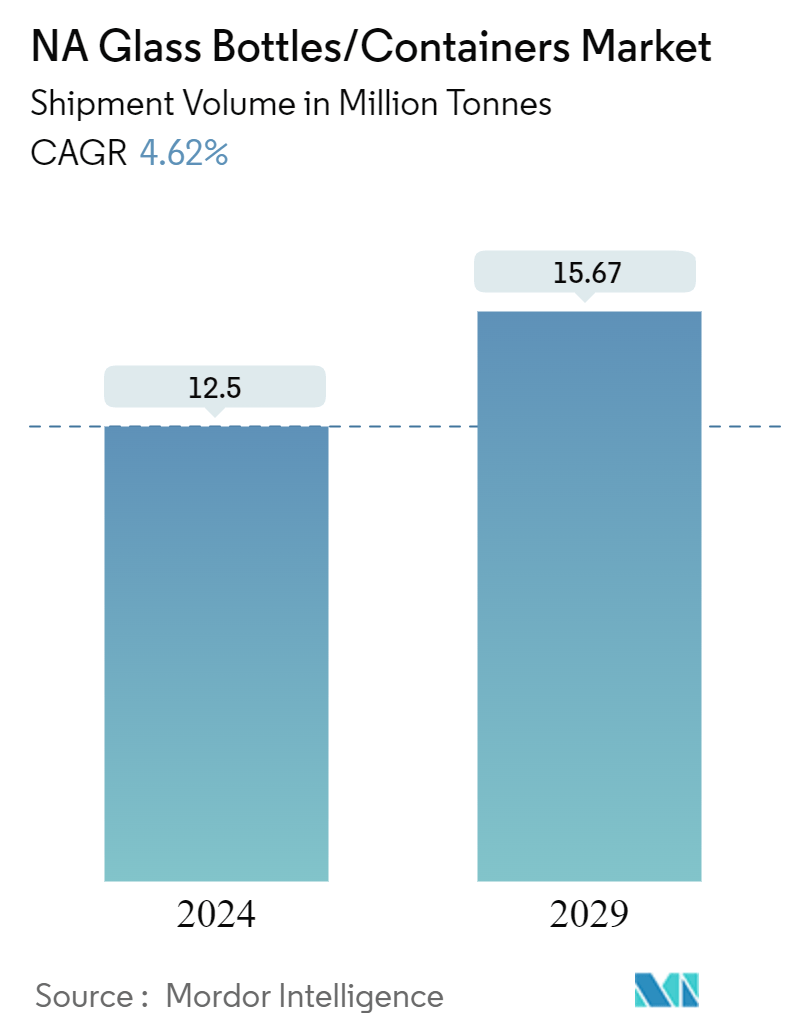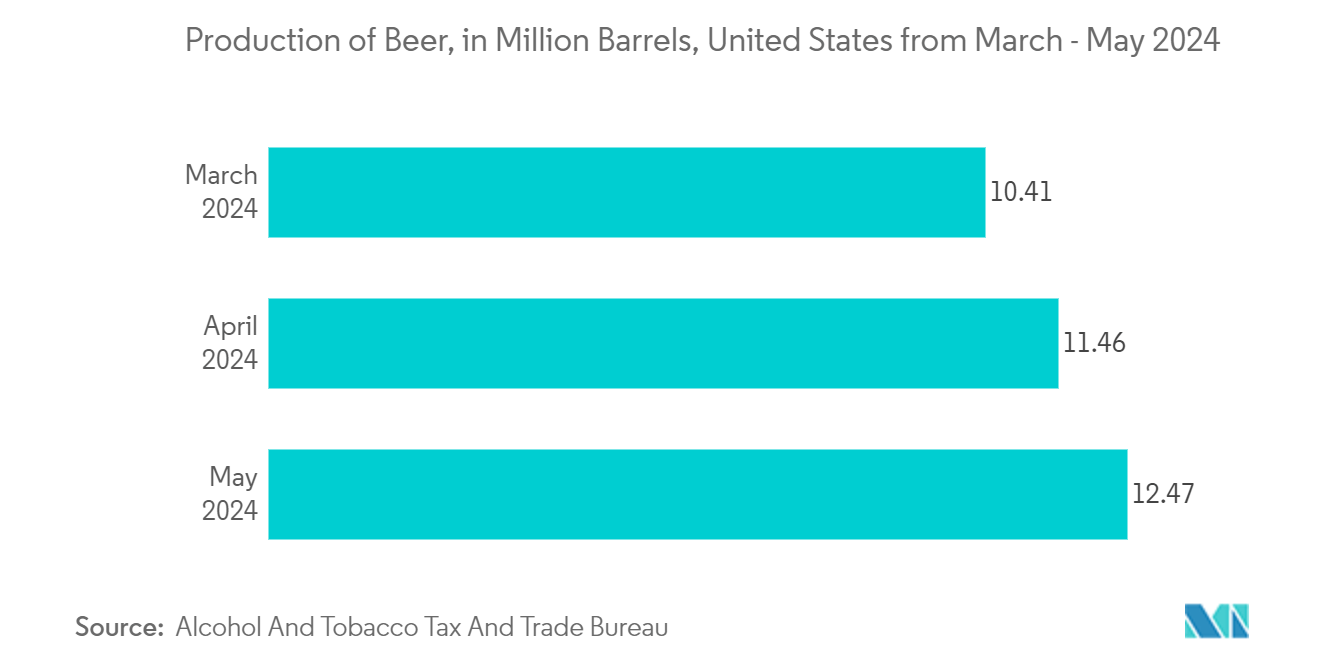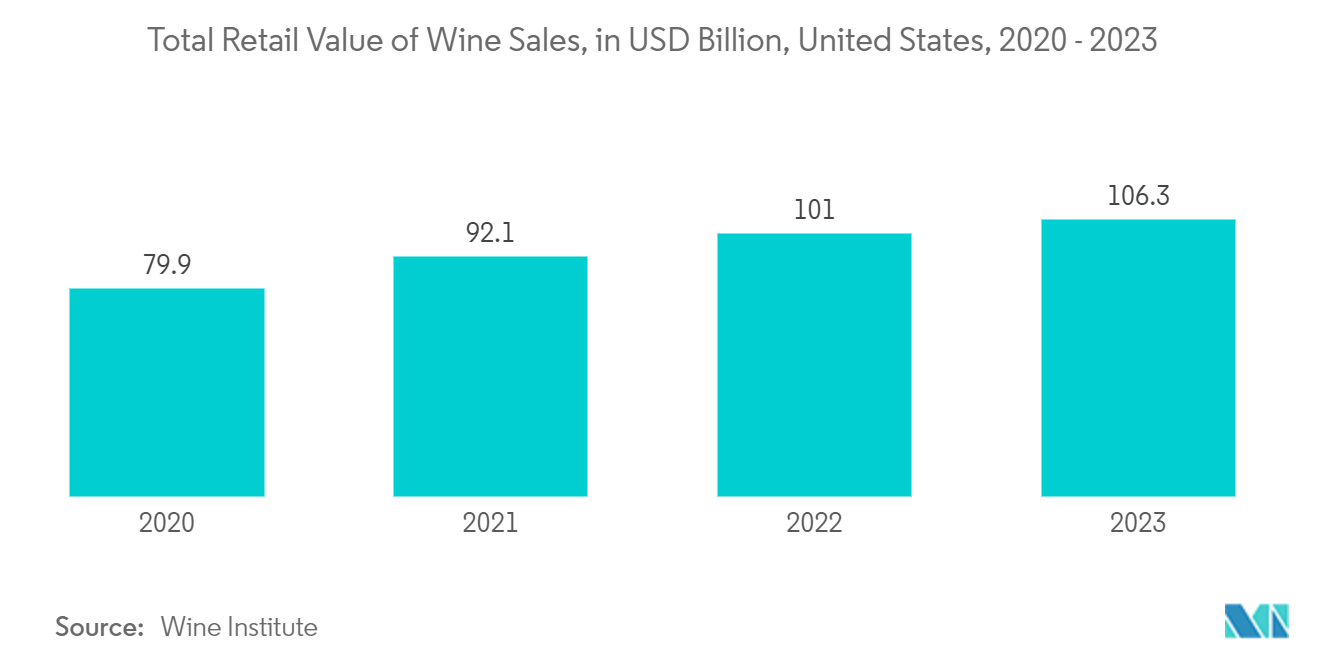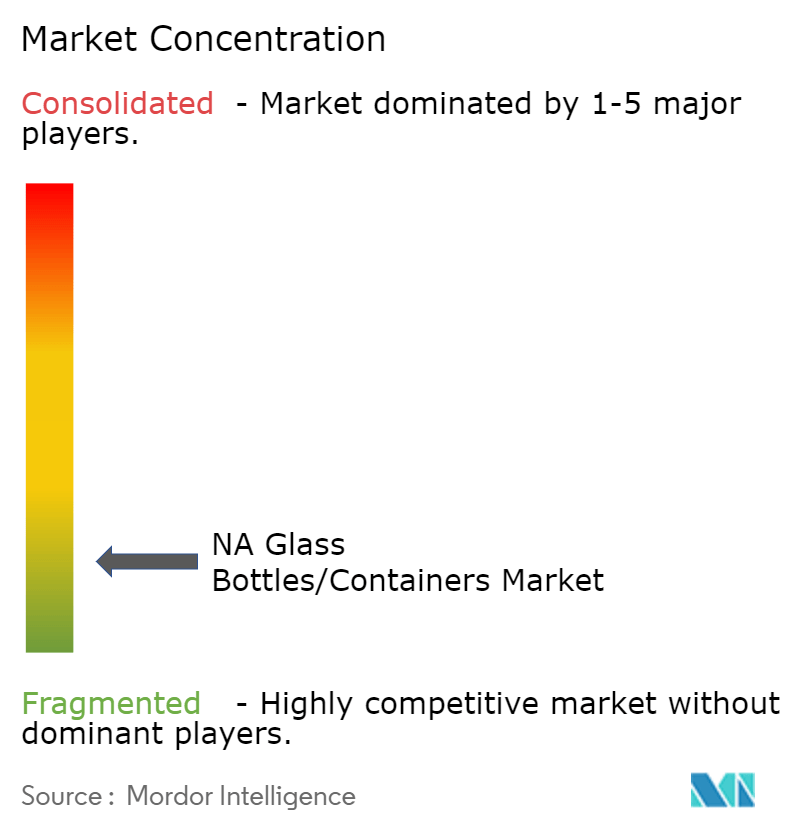North America Glass Bottles/Containers Market Size

| Study Period | 2019 - 2029 |
| Base Year For Estimation | 2023 |
| Market Volume (2024) | 12.5 Million tonnes |
| Market Volume (2029) | 15.67 Million tonnes |
| CAGR (2024 - 2029) | 4.62 % |
| Market Concentration | Low |
Major Players.webp)
*Disclaimer: Major Players sorted in no particular order |
North America Glass Bottles/Containers Market Analysis
The NA Glass Bottles/Containers Market size in terms of shipment volume is expected to grow from 12.5 Million tonnes in 2024 to 15.67 Million tonnes by 2029, at a CAGR of 4.62% during the forecast period (2024-2029).
- Driven by rising consumption in sectors like food and beverage, cosmetics, and pharmaceuticals, the North American container glass market is on an upward trajectory. As consumers increasingly prioritize safe and healthy packaging, glass has found its way into diverse categories. This is especially pronounced in the beverage sector, where premium products and craft beverages often come in glass bottles.
- Moreover, cutting-edge technologies in embossing, shaping, and artistic finishes are elevating the allure of glass packaging. Such innovations not only offer enhanced customization and branding but also make glass containers a go-to choice for companies aiming for standout packaging. The industry's push towards lightweight glass technologies addresses transportation cost concerns and environmental implications, further fueling market expansion.
- In the U.S., a surge in alcoholic beverage consumption is driving a robust demand for packaging, especially glass bottles. This demand mirrors the expanding range of alcoholic offerings and a consumer tilt towards premium packaging. Glass bottles are preferred not just for their recyclability and premium look, but also for their prowess in preserving beverage quality and taste. The craft beer trend and the emergence of artisanal spirits have amplified the appetite for top-tier glass packaging.
- Data from the 2023 National Survey on Drug Use and Health (NSDUH) reveals that 218.7 million U.S. adults (84.9% of those 18 and older) have consumed alcohol at some point. Such a significant consumer base ensures a steady demand for varied packaging solutions in the beverage sector. Glass bottles, with their versatility and appeal, remain dominant, and manufacturers are innovating to cater to the changing preferences of both producers and consumers.
- Glass Global reports that North America produced 8,389,233 tonnes of glass bottles and containers across sectors, with an annual capacity of 9,321,370 tonnes. This underscores the region's formidable presence in the glass packaging arena. The robust production capacity and volume signal not just a strong infrastructure but also a thriving demand, spanning industries like food and beverage, pharmaceuticals, and cosmetics.
- Additionally, data from the International Trade Centre highlights the U.S. exported around 141,143 tonnes of glass packaging. This not only points to a burgeoning opportunity in the glass packaging realm but also underscores the international demand for North American glass products, likely attributed to their quality and the region's manufacturing prowess. The blend of substantial domestic production and significant export figures accentuates the North American glass packaging industry's strength and growth trajectory.
- As container glass finds increasing adoption across sectors in the region, recycling has emerged as a critical focus. Industries like food and beverage, pharmaceuticals, and cosmetics are generating substantial glass waste due to their heightened use of container glass. Efficient recycling is vital for waste management, minimizing environmental impact, and championing sustainability. With government regulations leaning towards sustainable packaging, manufacturers are increasingly turning to glass solutions. Collectively, these dynamics are propelling the growth of North America's glass packaging market.
North America Glass Bottles/Containers Market Trends
Alcoholic Beverage Segment is Expected to Witness Significant Growth
- Alcohol manufacturers are rolling out new versions of their products in glass bottles, a move anticipated to positively influence the market. By adopting glass packaging, these manufacturers aim to boost product appeal and reshape consumer perceptions, capitalizing on the premium image associated with glass. Glass bottles not only preserve the product's taste and quality more effectively but also offer heightened recyclability and an upscale feel. Many consumers equate glass packaging with superior beverage quality, often justifying a premium price tag.
- Moreover, glass facilitates unique and creative bottle designs, allowing brands to differentiate themselves on store shelves.
- This pivot to glass packaging resonates with the rising consumer demand for sustainable and eco-friendly options, given that glass is entirely recyclable and boasts multiple reuse capabilities.
- For example, in September 2024, Diageo-owned Johnnie Walker unveiled a limited edition Blue Label Ultra, showcasing the world's lightest 700ml glass bottle tailored for Scotch whisky. This pioneering packaging marks a notable leap in sustainable whisky bottling.
- The North American beer packaging sector is largely influenced by evolving cultural trends, a growing population, urbanization, and a surge in beer's popularity among younger demographics. Continued investments and a broadening beer distribution network across regions are likely to uphold these trends, potentially invigorating the market for glass bottles and containers.
- From March to May 2024, U.S. beer production in bottles and cans fluctuated between 10.41 million and 12.47 million barrels, underscoring the nation's demand for packaged beer. Even though the U.S. witnessed a 5% dip in beer production and imports in 2023, and craft brewer volume sales fell by 1%, the market remains buoyed by a rising beer consumption trend.
- The dip in production and imports could stem from shifts in consumer preferences, economic factors, or regulatory changes. Yet, the uptick in beer consumption hints at untapped growth and innovation avenues in the industry, possibly spurred by new beer varieties, intensified marketing, or evolving consumer behaviors.
- In North America, a growing segment of consumers is embracing sustainable lifestyles, notably in their efforts to curb plastic waste. This movement is propelling the wine and spirits market's shift towards glass bottles. Many consumers view glass bottles as more eco-friendly than their plastic counterparts and associate them with premium product quality. This perception resonates with environmentally-conscious consumers, often willing to pay a premium for sustainable packaging. Furthermore, looming government regulations aimed at curbing plastic usage could further amplify the demand for glass bottles in the alcoholic beverage sector.

United States is Expected to Account for Major Market Share
- The United States represents one of the world's largest packaging markets, featuring numerous key players producing glass bottles and containers for various industries, including food and beverage, personal care, and pharmaceuticals. The country's economic growth and rising consumer expenditure on food, drinks, pharmaceuticals, and personal care products drive the demand for glass bottle and container packaging solutions.
- This trend is further supported by the increasing preference for sustainable and recyclable packaging options, with glass being favored due to its eco-friendly properties. The growing craft beverage industry, particularly in beer and spirits, has also contributed to the increased demand for specialized glass packaging. The pharmaceutical sector's expansion, driven by an aging population and advancements in healthcare, has also bolstered the need for high-quality glass containers that meet stringent safety and preservation standards.
- The United States offers a favorable environment for business ventures due to its strong economy, comprehensive business immigration system, diverse consumer base, innovation-driven culture, and business-friendly policies. These factors make the USA an attractive destination for entrepreneurs and companies looking to expand or establish new operations. The country's robust infrastructure, advanced technology sector, and access to capital further enhance its appeal for businesses across various industries.
- The growth of e-commerce platforms and evolving consumer behaviors present significant opportunities for online retailers. The digital marketplace has experienced rapid expansion, driven by increased internet penetration, mobile device usage, and changing shopping habits. This shift has created a fertile ground for businesses to reach a wider audience and implement innovative sales strategies.These trends create potential opportunities for various industries, including glass packaging.
- As consumers become more environmentally conscious and seek sustainable solutions, glass packaging manufacturers can capitalize on the demand for recyclable and reusable containers. Additionally, the growing preference for premium and artisanal products in niche markets often aligns well with the perceived quality and aesthetic appeal of glass packaging, presenting further growth prospects for the industry.
- In the United States, Millennial and Gen X consumers have been driving the growth in wine consumption. These demographic groups have shown an increasing preference for wine, influencing market trends and product offerings. Their evolving tastes and purchasing habits have significantly impacted the wine industry's direction. The total retail value of wine sales in the US reached approximately USD 106.3 billion in 2023. This substantial figure reflects the robust nature of the American wine market and its continued expansion. The sales value growth indicates increased consumption and a potential shift towards premium or higher-priced wine products.
- This trend indicates an increasing demand for high-quality glass bottles in wine packaging. As consumers become more discerning, there is a growing emphasis on the overall presentation and quality of wine products. Glass bottles, particularly those of superior quality, play a crucial role in preserving the wine's integrity and enhancing its perceived value. The packaging industry, especially glass manufacturers, will likely benefit from this trend as wineries seek to meet consumer expectations for premium packaging solutions.

North America Glass Bottles/Containers Industry Overview
The North America container glass market is fragmented, with numerous global and regional players competing for market share. Key companies in this space include O-I Glass, Inc., Ardagh Group S.A., MJS Packaging, and Anchor Glass Container Corporation. These firms and other market participants contribute to a diverse and competitive landscape.
As the market evolves, innovation has become crucial in maintaining and growing sustainable competitive advantage. Companies invest in research and development to improve product offerings, enhance manufacturing processes, and meet changing consumer demands. This focus on innovation drives advancements in lightweight glass production, improved recycling techniques, and the development of specialized coatings for enhanced product protection.
The increasing emphasis on sustainability and environmental concerns has also become a significant driver in the glass bottles and containers market. Many companies are adopting eco-friendly practices and promoting the recyclability of glass as a key selling point. This trend will likely continue shaping the competitive landscape and influencing market dynamics in the coming years.
North America Glass Bottles/Containers Market Leaders
-
O-I Glass, Inc
-
Ardagh Group S.A.
-
MJS Packaging
-
Anchor Glass Container Corporation
-
O.Berk Company, L.L.C.
*Disclaimer: Major Players sorted in no particular order

North America Glass Bottles/Containers Market News
- October 2024: Ardagh Glass Packaging-North America (AGP-North America), a division of Ardagh Group, has expanded its American-made bottle portfolio with a new 500ml Celebration bottle in flint (clear) glass. This addition complements the 500ml Celebration bottle in amber (brown) glass, part of AGP-North America's beer and beverage bottle collection. The new flint glass bottles, designed and manufactured in the United States, are packaged in plain craft cardboard cases with partition dividers, each containing 12 bottles.
- July 2024: Ardagh Glass Packaging-North America (AGP-North America), a business unit of Ardagh Group, has expanded its American-made bottle offerings with a new series of craft beverage containers. The new 12oz glass bottles are emerald green, flint, and amber. AGP-North America designs and produces these 100% recyclable glass bottles domestically.
North America Glass Bottles/Containers Market Report - Table of Contents
1. INTRODUCTION
1.1 Study Assumptions and Market Definition
1.2 Scope of the Study
2. RESEARCH METHODOLOGY
3. EXECUTIVE SUMMARY
4. MARKET INSIGHTS
4.1 Market Overview
4.2 Export-Import Data of Container Glass
4.3 PESTEL Analysis of Container Glass Market
4.4 Industry Standard and Regulation For Container Glass Use For Packaging
4.5 Raw Material Analysis and Material Consideration For Packaging
4.6 Sustainability Trends For Glass Packaging
4.7 Container Glass Furnace and Location in North American Region
5. MARKET DYNAMICS
5.1 Market Drivers
5.1.1 Growing Demand from Food and Beverage Industry
5.1.2 Sustainability and Recyclability Initiatives Are Expanding End-Users Demand For Glass Packaging
5.2 Market Restraints
5.2.1 High Carbon Footprint due to Glass Manufacturing
5.2.2 Operation and Logistical Concerns
5.3 Trade Scenario - Analysis of the Historical and Current Export-Import Paradigm For Container Glass Industry
6. MARKET SEGMENTATION
6.1 By End-user Vertical
6.1.1 Bevarages
6.1.1.1 Alcoholic (Qualitative Analysis For Segment Analysis)
6.1.1.1.1 Beer and Cider
6.1.1.1.2 Wine and Spirits
6.1.1.1.3 Other Alcoholic Beverages
6.1.1.2 Non-alcoholic (Qualitative Analysis For Segment Analysis)
6.1.1.2.1 Carbonated Soft Drinks
6.1.1.2.2 Milk
6.1.1.2.3 Water and Other Non-alcoholic Beverages
6.1.2 Food
6.1.3 Cosmetics
6.1.4 Pharmaceutical
6.1.5 Other End-user Verticals
6.2 By Country
6.2.1 United States
6.2.2 Canada
7. COMPETITIVE LANDSCAPE
7.1 Company Profiles
7.1.1 O-I Glass, Inc
7.1.2 Ardagh Group S.A.
7.1.3 Gerresheimer AG
7.1.4 Arksansas Glass Container Corporation
7.1.5 MJS Packaging
7.1.6 O.Berk Company, L.L.C.
7.1.7 Kaufman Container Company
7.1.8 Burch Bottle & Packaging, Inc.
7.1.9 Anchor Glass Container Corporation
7.1.10 West Coast Container Inc.
7.1.11 PGP Glass Private Limited
- *List Not Exhaustive
8. ANALYSIS OF MAJOR FURNACE SUPPLIERS TO THE CONTAINER GLASS PLANTS ACROSS NORTH AMERICA
9. FUTURE OUTLOOK OF THE MARKET
North America Glass Bottles/Containers Industry Segmentation
Glass bottles and containers offer an effective solution for preserving consumables, ensuring their safety, freshness, and quality over extended periods while facilitating transportation. These packaging solutions are designed to protect contents from external factors such as light, air, and moisture, which can degrade product quality. The alcoholic and non-alcoholic beverage industries primarily utilize glass bottles and containers due to their chemical inertness, sterility, and non-permeability. These properties make glass ideal for maintaining beverages' flavor, aroma, and overall integrity.
Additionally, glass packaging is recyclable and environmentally friendly, aligning with growing consumer preferences for sustainable products. This market analysis encompasses vital end-user industries, including beverages, food, pharmaceuticals, and cosmetics. Each sector has specific requirements for packaging, and glass containers are tailored to meet these diverse needs, from preserving food products to ensuring the stability of pharmaceutical formulations and protecting the quality of cosmetic items.
The North America container glass market is segmented by end-user vertical (beverages [alcoholic beverages (wines and spirits, beer, and cider, other alcoholic beverages), non-alcoholic beverages (carbonated soft drinks, milk, water, and other non-alcoholic beverages)] food, cosmetics, pharmaceuticals, and other end-user vertical) and by country (United States, Canada). The report offers market forecasts and size in volume (tonnes) for all the above segments.
| By End-user Vertical | ||||||||||||
| ||||||||||||
| Food | ||||||||||||
| Cosmetics | ||||||||||||
| Pharmaceutical | ||||||||||||
| Other End-user Verticals |
| By Country | |
| United States | |
| Canada |
North America Glass Bottles/Containers Market Research FAQs
How big is the North America Glass Bottles/Containers Market?
The North America Glass Bottles/Containers Market size is expected to reach 12.5 million tonnes in 2024 and grow at a CAGR of 4.62% to reach 15.67 million tonnes by 2029.
What is the current North America Glass Bottles/Containers Market size?
In 2024, the North America Glass Bottles/Containers Market size is expected to reach 12.5 million tonnes.
Who are the key players in North America Glass Bottles/Containers Market?
O-I Glass, Inc, Ardagh Group S.A., MJS Packaging, Anchor Glass Container Corporation and O.Berk Company, L.L.C. are the major companies operating in the North America Glass Bottles/Containers Market.
What years does this North America Glass Bottles/Containers Market cover, and what was the market size in 2023?
In 2023, the North America Glass Bottles/Containers Market size was estimated at 11.92 million tonnes. The report covers the North America Glass Bottles/Containers Market historical market size for years: 2019, 2020, 2021, 2022 and 2023. The report also forecasts the North America Glass Bottles/Containers Market size for years: 2024, 2025, 2026, 2027, 2028 and 2029.
North America Glass Bottles/Containers Industry Report
Statistics for the 2024 North America Glass Bottles/Containers market share, size and revenue growth rate, created by Mordor Intelligence™ Industry Reports. North America Glass Bottles/Containers analysis includes a market forecast outlook to 2029 and historical overview. Get a sample of this industry analysis as a free report PDF download.



